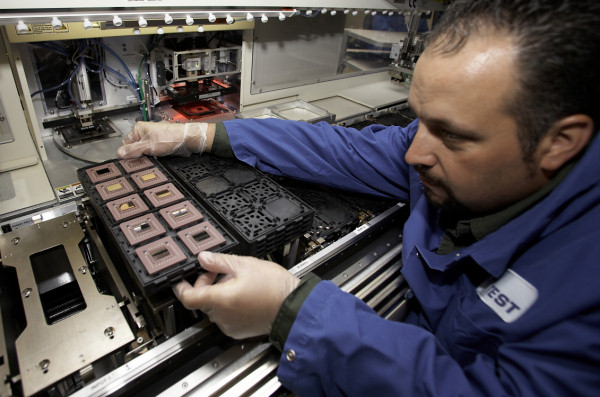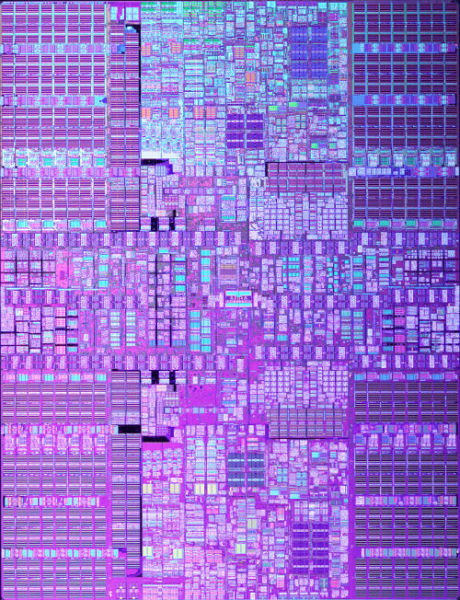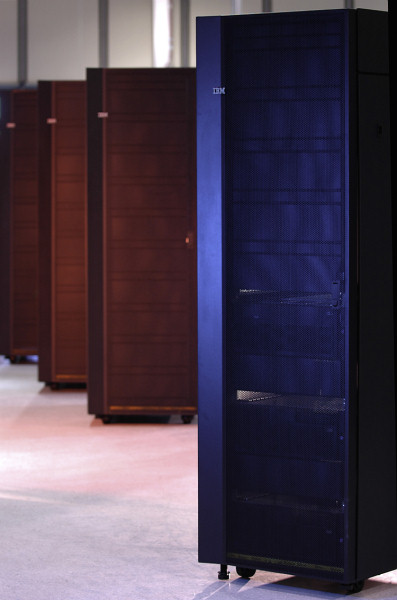 |
||
|
||
| ||
AOpen Introduces HD-Capable miniPC MP945-VDR Barebone IBM Unleashes 4.7GHz POWER6 Processor Intel, STMicroelectronics And Francisco Partners Establish A New Flash Memory Company AOpen Introduces HD-Capable miniPC MP945-VDR Barebone
AOpen miniPC MP945-VDR offers various interfaces, including S-Video, Y/Pb/Pr composite and DVI with HDMI adapter. The HDMI (High-Definition Multimedia Interface) is the first industry-supported uncompressed, all-digital video interface that provides an interface between any video sources over a single cable. It supports high-definition video formats such as 720p, 1080i, and 1080p. Speaking of audio, the barebone features integrated 5.1ch sound and S/PDIF outputs. Bundled is an IR remote controller designed for Microsoft Windows XP MCE and compatible with Vista Home Premium and Ultimate. Source: AOpen
IBM Unleashes 4.7GHz POWER6 Processor IBM simultaneously launched its fastest microprocessor and an ultra-powerful new computer server that leverages the chip’s breakthroughs in energy conservation and virtualization technology. The new server is the first ever to hold all four major benchmark speed records for business and technical performance. At 4.7 GHz, the dual-core POWER6 processor doubles the speed of the previous generation POWER5 while using nearly the same amount of electricity to run and cool it. This means customers can use the new processor to either increase their performance by 100 percent or cut their power consumption virtually in half.  IBM Test Manufacturing Technician B.J. Barrett tests POWER6 microprocessors at the company's Burlington, Vermont facility. IBM’s new 2- to 16-core server also offers three times the performance per core of the HP Superdome machine, based on the key TPC-C benchmark. The processor speed of the POWER6 chip is nearly three times faster than the latest HP Itanium processor that runs HP’s server line. Even more impressive, the processor bandwidth of the POWER6 chip – 300 gigabytes per second - could download the entire iTunes catalog in about 60 seconds – 30 times faster than HP’s Itanium. But the new server offers more than just raw performance – it is the world’s most powerful midrange consolidation machine, containing special hardware and software that allows it to create many “virtual” servers on a single box. IBM calculates that 30 SunFire v890s can be consolidated into a single rack of the new IBM machine, saving more than $100,000 per year on energy costs. According to IDC, IBM has gained 10.4 points of UNIX revenue share in the past five years - versus HP’s loss of 5.3 points and Sun’s loss of 1.4 points. IBM will use the new machine to target customers with less-efficient HP, Sun and Dell servers.  790 million transistors of the POWER6 chip. The new IBM System p 570, running the POWER6 processor, claims the No.1 spots in the four most widely used performance benchmarks for Unix servers – SPECint2006 (measuring integer-calculating throughput common in business applications), SPECfp2006 (measuring floating point-calculating throughput required for scientific applications), SPECjbb2005 (measuring Java performance in business operations per second) and TPC-C (measuring transaction processing capability). This is the first time that a single system has owned all four categories. The new System p 570 now holds 25 benchmark records across a broad portfolio of business and technical applications. The performance leadership is largely attributed the system’s balanced design. Unlike competing servers, IBM succeeded in scaling the new server’s processor performance and system design (cache sizes and bandwidth) in a balanced way. The POWER6 chip has a total cache size of 8MB per chip – four times the POWER5 chip – to keep pace with the awesome processor bandwidth. By contrast, many other servers concentrate mainly on processor performance, at the expense of the server’s ability to feed data to the chip at a rate that takes advantage of the processor’s speed.  POWER6's cross section photographed using a scanning electron microscope. It shows two transistors (gold color) out of the 790 million. The POWER6 chip in the new IBM System p 570 server owns a number of industry “firsts.” It is the first UNIX microprocessor able to calculate decimal floating point arithmetic in hardware. Until now, calculations involving decimal numbers with floating decimal points were done using software. The built-in decimal floating point capability gives tremendous advantage to enterprises running complex tax, financial and ERP programs. The POWER6 processor is built using IBM’s 65-nanometer process technology. Coming at a time when some experts have predicted an end to Moore’s Law, which holds that processor speed doubles every 18 months, the IBM breakthrough is driven by a host of technical achievements scored during the five-year research and development effort to develop the POWER6 chip. These include:
The POWER6 chip includes additional techniques to conserve power and reduce heat generated by POWER6 processor-based servers. Processor clocks can be dynamically turned off when there is no useful work to be done and turned back on when there are instructions to be executed. Power saving is also realized when the memory is not fully utilized, as power to parts of the memory not being utilized is dynamically turned off and then turned back on when needed. In cases where an over-temperature condition is detected, the POWER6 chip can reduce the rate of instruction execution to remain within an acceptable, user-defined temperature envelope. IBM plans to introduce the POWER6 chip throughout the System p and System i server lines.  The first IBM System p 570 server. Also announced today, IBM is unveiling an industry-first with a new feature that provides customers with the ability to move live virtual machines from one physical UNIX server to another while maintaining continuous availability. Coined the POWER6 Live Partition Mobility function, this technology - currently in beta, with general availability planned for later this year - enables customers to move active virtualized partitions without temporarily suspending them. While competing offerings require a disruptive reboot of the UNIX system and software stack, IBM is the first vendor to help clients optimize resource utilization on a broader scale by allowing administrators to think of large groups of servers as a fluid resource rather than focusing on each server as a single entity with a dedicated purpose. Source: IBM
Intel, STMicroelectronics And Francisco Partners Establish A New Flash Memory Company STMicroelectronics, Intel and Francisco Partners announced they have entered into a definitive agreement to create a new independent semiconductor company from the key assets of businesses which last year generated approximately $3.6 billion in combined annual revenue. The new company's strategic focus will be on supplying flash memory solutions for a variety of consumer and industrial devices, including cellular phones, MP3 players, digital cameras, computers and other high-tech equipment. The new company will combine key research and development, manufacturing and sales and marketing assets of Intel and STMicroelectronics into a streamlined worldwide structure with the scale to produce cost-effective and innovative non-volatile memory solutions. Under the terms of the agreement, STMicroelectronics will sell its flash memory assets, including its NAND joint venture interest and other NOR resources, to the new company while Intel will sell its NOR assets and resources. In exchange, Intel will receive a 45.1 percent equity ownership stake and a $432 million cash payment at close. STMicroelectronics will receive a 48.6 percent equity ownership stake and a $468 million cash payment at close. Francisco Partners L.P., a Menlo Park, Calif.-based private equity firm, will invest $150 million in cash for convertible preferred stock representing a 6.3 percent ownership interest, subject to adjustment in certain circumstances. Concurrently, the parties have arranged for the new company to receive firm commitments for a $1.3 billion term loan and $250 million revolver. The term loan will be underwritten by a consortium of banks. Proceeds from the term loan will be used for working capital and payment to Intel and STMicroelectronics for the purchase price. The transaction is subject to regulatory approvals and customary closing conditions and is expected to occur in the second half of 2007. The new company, to be managed by Brian Harrison as CEO-designate and Mario Licciardello, currently corporate vice president of ST's Flash Memories Group as COO-designate, will be headquartered in Switzerland and incorporated in the Netherlands with nine main research and manufacturing locations around the world and approximately 8,000 employees. The company will also benefit from a worldwide sales force. Source: Intel
Write a comment below. No registration needed!
|
Platform · Video · Multimedia · Mobile · Other || About us & Privacy policy · Twitter · Facebook Copyright © Byrds Research & Publishing, Ltd., 1997–2011. All rights reserved. |